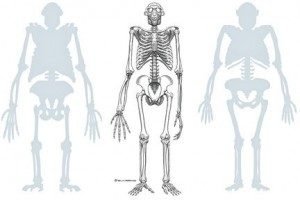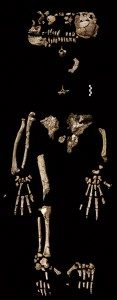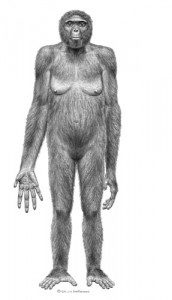 Since her discovery late in the field season of 1974, by French Geologist Maurice Taieb and American Anthropologist Donald Johansen, AL 288-1 has been the gold standard of evolutionary discussion regarding the origins of humanity on Earth. You might not recognise her by the reference number given to her in the field, but I’m sure you’re more familiar with her nickname; ‘Lucy’.[1]
Since her discovery late in the field season of 1974, by French Geologist Maurice Taieb and American Anthropologist Donald Johansen, AL 288-1 has been the gold standard of evolutionary discussion regarding the origins of humanity on Earth. You might not recognise her by the reference number given to her in the field, but I’m sure you’re more familiar with her nickname; ‘Lucy’.[1]
Australopithecus aferensis, a near complete fossilised skeleton representing what many scientists believed was the earliest example of our own evolutionary lineage ever found and they nicknamed her Lucy. Lucy has been poked and proded, explored and examined and is generally understood as the closest specimine ever found linking modern humans to the early hominid species from whom the great apes decended. It was Charles Darwin who first suggested that men decended from apes, to the indignation of many a royal and pious man of the time, and science has done a great deal of studious work since that day, most of which serves to confirm Darwin’s conclusions.
Lucy was found in an area of central Africa, Ethiopia to be pricise; at Hadar in the Awash Valley of Ethiopia’s Afar Depression, and by a consensis of all estimates, Lucy is 3.2 million years old. It was believed that Lucy would remain the earliest hominid fossil to be found, and thus the oldest known example of hominid evolution in the fossil record, however a recent discovery very near to where Lucy was found has upset the apple cart of many an anthropologist the world over.

The fossilized skeletal remains of ‘Ardi’
Ardipithecus ramidus, nicknamed ‘Ardi’, is now the focus of much international scientific attention; found in the Ethiopian badlands near the Awash River in 1994 by an international team of acheologists, Ardi has been estimated (through radiometric dating) to be more than 4.4 million years old.[2]
You, as many others, are probably wondering why this is so significant, and though it isn’t immediately apparent, the importance of this discovery is such that it not only confirms Darwin’s Evolutionary theories to be dead on correct, but it means that our own lineage goes back much further into the Earth’s history than ever thought before. For you see, Lucy, and her elder partner Ardi are the oldest examples of bipedal hominids.
Before we get to the nuts and bolts of why bipedal locomotion is so important to the evolutionary discussion of man, lets bring those numbers into perspective. Figure 1 (below) is a graphic representation of the ages of Lucy and Ardi, as well as the Bering Migration of prehistoric man from northern Europe to North America some 25,000 years ago (as a median estimation based on the many migration theories available), and the approximate commencement of the modern Iron Age some 3,200 (to 5000) years ago. We are currently in the 2nd millenia of the new Roman calendar, prior to the start of that calendar, Ardi celebrated 4000 millenia, though I suspect there may have been less noise and ruccus in her day.
Figure 1
As is plain to see, the current incarnation of mankind is but a blip on the scope of hominid life on the planet. A great deal more than four and a half million years of evolution has culminated in the social and technological marvel that is modern man; big brains, opposable thumbs and every other so-called unique human trait that is heralded as the thing that sets us apart from the beasts of our world.
But, among all those marvels of human ingenuity, the one trait that truly does set us apart from all other hominid species on Earth is bipedal locomotion; in other words, it’s the ability to walk on our own two feet that makes us unique.
Humans are the only mega-fauna mammal on the planet to use bipedal locomotion; sure some apes are known to walk on two legs, occasionally, and so are various species of bear, but none other than humans make a career out of it. Anthropology circles present a surprisingly clear picture of why early hominids developed a tendency to walk on two, instead of four limbs, all of it revolving around successful mating. At some point in our distant past, it became advantageous for our ancestors to walk on two legs, which would have been a serious detriment to our collective ability to out run predators. What it would have done was left our prehensile arms free to gather and carry much larger amounts of food and other resources back to a central den or nest, and thus utilising the various advantages of social groups for survival.
So, all is well and good for our learned scientists and theologians to ponder what Ardi and her younger cousin Lucy mean to our understanding of human history and development, but another thing these discoveries do as a sort of strange side effect, is open up possibilities for other theories of a cryptozoological nature.
4.4 Million years of evolution along a single branch of the biological tree of life. Four thousand millennia of practise and development and adaptation, and look how far we’ve come. Though let’s consider that for a moment; in that same 4 million years, countless species of mammal, amphibian, avian, and invertebrate have evolved, survived, extinguished or flourished among the influences and changes of nature. On other branches of this tree of life there are multiple examples of various species, even on our own branch (so-to-speak) there are -lesser apes and great apes- 22 different species of ape. Each species has its own specific characteristics and genetic make up, but each species is descended from the same ancient parent species as us…so why the wide variation in apes, and no variation in humans at all?[3]
Each hominid fossil that’s discovered, is inevitably labelled a direct evolutionary descendent of ours, or of the apes. If you were to look at the hominid branch on that tree of life, essentially there would be two dissecting lines, one representing us and one representing the apes. Though the ape’s line would show a vast number of its own intersecting lines, or divergent paths of evolution resulting in variant species of ape; but on our line there are far fewer deviations (if any).
 Why were we humans the only species on the planet to develop bipedal locomotion? Anthropologically speaking, the development of bipedal locomotion was the single most beneficial trait of our ancestors, leading to all of our current biological advantages, (i.e. big brain, prehensile dexterity, language etc.) which would seem to suggest that any other species which underwent the same bipedal development had an equal chance of achieving the same success, yet none did.
Why were we humans the only species on the planet to develop bipedal locomotion? Anthropologically speaking, the development of bipedal locomotion was the single most beneficial trait of our ancestors, leading to all of our current biological advantages, (i.e. big brain, prehensile dexterity, language etc.) which would seem to suggest that any other species which underwent the same bipedal development had an equal chance of achieving the same success, yet none did.
Or did they?
Are the various globally consistent wild-man legends evidence of a second species of hominid that developed along side mankind?
The one major barrier to almost all paleo-anthropological research is the unfortunate fact that the biological remains of ancient species rarely survive long enough to be studied. Our big brains, you could say, are the enemy of anthropology, in that our evolutionary ancestors were smart enough to not get caught in lava flows, or mud slides or any of the other such environmental catastrophes which normally provide science with the fossils from which these conclusions are drawn. So how, exactly, would we know if another species of hominid had developed (whether it survived for long or not)? The simple answer is that those cousins of ours would live on in story and legend.
Sounding familiar yet?
When put into perspective, along that four and a half million year journey from Ethiopia to UC Berkley’s Anthropology lab, there was well more than enough time and opportunity for such a species to develop, and for many years, scientists postulated that a large portion of the wild-man legends sprang from early conflicts between Homo-erectus and Cro-Magnon species on the plains of Africa and southern Europe, essentially culminating in an early cultural ethos about the dangers of the other species or tribes. But the evolution of culture is a much faster process than the evolution of biology.
The underlying point, as transparent as it is, is that in nature, opportunity usually equals advantage, and advantage equals survival, and ultimately, survival equals evolution.
All that would have been necessary for a creature, whether it be called a wild-man, Sasquatch, Bigfoot, or even Woodwose, to evolve and exists along side humanity, is opportunity. It seems that such opportunity existed in abundance; so maybe the question should not be ‘what if’, but moreover, ‘why not’?
[1] See: http://en.wikipedia.org/wiki/Lucy_(Australopithecus)
[2] See: http://en.wikipedia.org/wiki/Ardi and http://en.wikipedia.org/wiki/Ardipithecus
[3] To be clear, anthropology does not see race as an evolutionary variation, all humans are of the same species.

![graph[1] graph[1]](http://web.archive.org/web/20100726011346im_/https://paranormalpeopleonline.com/wp-content/uploads/2009/11/graph1.jpg)
